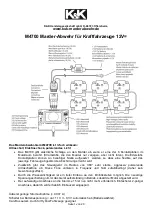
Retroreflection
If the reflective energy is greater than 100%, the beam is not reflected diffusely in all
directions; instead it is reflected in a targeted way (retroreflection). Thus a large part of
the emitted energy can be received by the laser distance measurer. Plastic reflectors
(cat’s eyes), reflective tape, and triple prisms have these properties.
Figure 6: Retroreflection
Reflective surfaces
The laser beam is almost completely deflected on reflective surfaces. This means that
an object hit by the deflected beam may be detected instead of the reflective surface.
Figure 7: Specular surfaces
Small objects
Objects that are smaller than the diameter of the laser beam cannot reflect the laser
light’s full energy. The portion of the light beam that does not reach the object is lost. If
all of the light reflected to the sensor is insufficient, the object may not be detected.
The portion of the light that does not reach the front object can be reflected by a larger
object in the background. If all of the light reflected to the sensor is sufficient, this
object is detected. This can lead to a corruption of the measured value.
Figure 8: Object smaller than the laser beam diameter
3.5.5
Scanning range
The scanning range of the device depends on the remission of the object to be
detected. The better a surface reflects the incident beam back to the device, the
greater the scanning range of the device.
3
PRODUCT DESCRIPTION
14
O P E R A T I N G I N S T R U C T I O N S | MRS1000
8020494/1AZF/2021-05-10 | SICK
Subject to change without notice















































